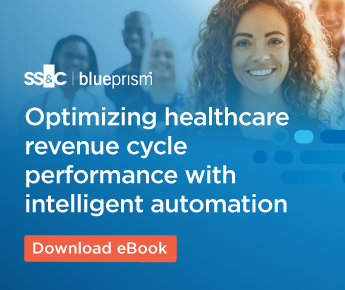Blog
22 Use Cases of IA and RPA in Healthcare
Contact Us
The last three years have certainly placed a strain on the U.S. healthcare system. Healthcare services are being pushed to the brink: resources are stretched to their limit and healthcare operating staff face unrelenting pressures.
Against this backdrop, it’s essential to optimize revenue cycles. In years of financial difficulties and uncertainty around payments, healthcare providers and payers urgently need to recoup revenue by streamlining their processes and finding better ways to save employee time and reduce costs.
Revenue Cycle Management (RCM), the method for handling healthcare claims adjudication, is the revenue generator for healthcare providers and the process for negotiating claims payment for payers. RCM encompasses the entire payment and claims adjudication process for revenue generation, based on fee-for-service billing. Effective RCM is vital for healthcare organizations to stay operational and financially viable.
Currently, revenue cycles remain a major pain point for providers and payers, with slow and inefficient processes impacting productivity, cash flow, and critically, patient experience. The revenue cycle has long been a source of great frustration for patients. Billing errors, coding errors, delayed prior authorizations, unprecedented claims denial, and unpaid claims have contributed to widely held perceptions of inefficiency within the healthcare sector.
While new reimbursement models are undoubtedly coming down the line, most commercial healthcare organizations in the U.S. still rely primarily on fee-for-service methodologies. Revenue cycle optimization, therefore, will remain a critical priority for both providers and payers for the foreseeable future.
Automating the revenue cycle can help optimize your healthcare organization’s entire workflow, driving revenue and boosting your competitive advantage. But what is RCM automation and how can it work for you?
Intelligent automation (IA) involves robotic process automation (RPA), an automation technology that can simplify processes and realize value faster by eliminating mundane manual processes such as accounts receivable, prior authorization, insurance verification, claims processing and data entry. RPA deploys digital workers to perform time-consuming, repetitive tasks in the revenue cycle in real-time, giving more time to employees for patient-focused work.
Let’s start first with a few foundational definitions around IA: intelligent automation = RPA + AI + ML.

Intelligent automation (IA) links artificial intelligence—the simulation of human intelligence—with the capabilities of RPA—the simulation of human actions—to enable the expansion of automation capabilities.
Backed by IA, digital workers can easily integrate with other cognitive technologies like computer vision, natural language processing (NLP), and ML to expand the number of processes that can be automated—from the semi-structured, such as financial invoice processing and claim denial management, to the unstructured, such as email triage.
Robotic process automation (RPA) refers to the software that enables digital workers to carry out step-by-step tasks or business processes within existing systems and applications, much like a human would. The benefit of RPA, coupled with AI technology, is that it enables digital workers to use advanced cognitive automation capabilities with little human intervention.
Artificial intelligence (AI) describes the capability of a machine to imitate intelligent human behavior, or the simulation of intelligent behavior, in computers. Matched with RPA, AI enables businesses to analyze, categorize and extract unstructured data, improving the output of complex automated business processes.
Machine learning (ML) is an application of AI that enables a computer, system, or technology to learn and improve its performance by continuously incorporating new data into an existing statistical model, or developing new behaviors based on experience.
Healthcare organizations need better ways to deploy IA and RPA for robust revenue cycle management automation. SS&C Blue Prism can help you build an effective revenue cycle automation to get your organization prepared, optimized, and value-driven.
With IA, healthcare providers and payers can have access to a software platform that automates any management processes, interacting with line-of-business applications in the same way as a human worker, but more quickly, accurately, and 24 hours a day, seven days a week. RPA provides various benefits to RCM and healthcare providers, including:
Intelligent, AI-enabled digital workers act as the integration layer between existing legacy systems to ensure data and information flow quickly and safely within and beyond the organization. This eliminates the need to dedicate prohibitively expensive human resources to undertake these tasks. And like people, digital workers can develop new skills, getting smarter and more capable over time. Working in collaboration with people, a digital workforce allows for faster and more productive RCM processes.
There are many ways in which RCM automation is beneficial. RPA can improve processes across the healthcare organization, from patients and providers to accounts receivable. Here are some examples of where you can automate your RCM:
Intelligent automation and RPA have the potential to revolutionize the healthcare industry by drastically improving the revenue cycle management processes.
IA simplifies your RCM; it automates patient data migration and processing, insurance data, medical billing, and insurance claim processing. By optimizing these processes with automation, your organization can reduce manual tasks for employees, implement faster department-wide communication, receive real-time data and statuses, digitize files, create error-free and accurate data, improve patient and staff experience, and so on.
With RPA, you can securely access audit trails and maintain compliance with HIPAA and other regulatory requirements, while keeping your processes operating more efficiently and increasing your revenue.

If your network blocks YouTube, you may not be able to view the video on this page. In this case, please use another device. Pressing play on the video will set third-party YouTube cookies. Please read our Cookies Policy for more information.